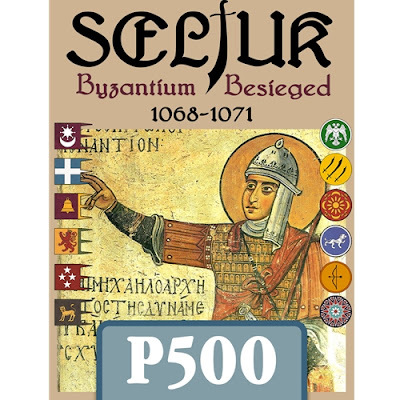miércoles, 25 de enero de 2023
Seljuk: Byzantium Besieged, 1068-1071 Interview: Justin Fassino
Seljuk: Byzantium Besieged, 1068-1071 Entrevista: Justin Fassino
Seljuk—Volumen VI de la serie Levy & Campaign de Volko Ruhnke—lleva a los jugadores a los desafíos de la logística medieval y la maniobra en Asia Menor durante el enfrentamiento entre el poder cristiano ortodoxo y el musulmán en el período previo a la culminante Batalla de Manzikert. Los jugadores asumirán el papel de los romanos orientales o los turcos selyúcidas en su intento de dejar su huella en esta tierra histórica. Los objetivos de victoria asimétricos y las adiciones nuevas y únicas al sistema significan un juego dinámico del gato y el ratón entre estos dos grandes poderes.
Las reglas e imágenes aquí mostradas no son finales.
Lo podéis encontrar en P500
miércoles, 18 de enero de 2023
Imperial Eagles Entrevista: Chris Janiec
Imperial Eagles Interview: Chris Janiec
miércoles, 11 de enero de 2023
Almoravid - Reseña
Almoravid - Review
In 2019, the first game in the GMT Levy and Campaign series, designed by Volko Ruhnke, is released. The medieval period is not one of my favorites and that period and conflict were unknown to me, but I decided to give it a try. It opened up a whole new vision for me regarding the world of wargaming. But, what is the cam and campaign series about?
The games in this series are operational games set, for the time being, in the Middle Ages. These games stand out for their logistics section and it will be around what everything revolves around. The game pieces will represent feudal lords, each feudal lord has a board where his troops, supplies, transport, capacities, etc. will be. Movement is point to point and is limited. Each turn is divided into two phases: Levy and Campaign
Our first task in the Campaign phase will be to create the action deck. Depending on each season, more or fewer cards will be used. Each lord has several actions that he can perform during his activation and the creation of this deck will indicate the order of activation. During this same phase, the actions of each lord will be carried out as they come out of the deck. These actions include foraging, movements, sieges, etc.
miércoles, 4 de enero de 2023
A Fading Star Entrevista: Yann de Villeneuve
A Fading Star Interview: Yann de Villeneuve
Tsar Interview: Paul Hellyer
Tsar reimagines the reign of Nicholas II, the last Tsar of Russia. Players occupy the center of his regime, advising and influencing him w...

-
Today I bring you an introduction to GMT's Next War series . In this article I do not want to focus on the games but on the system itse...
-
Tsar reimagines the reign of Nicholas II, the last Tsar of Russia. Players occupy the center of his regime, advising and influencing him w...















